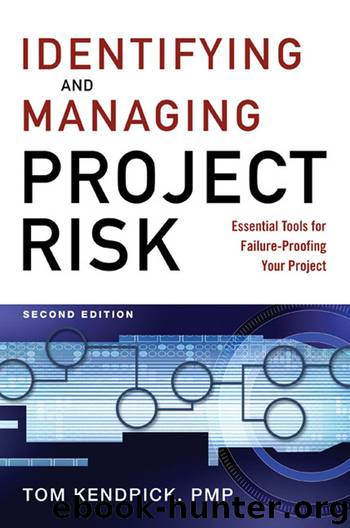Identifying and Managing Project Risk: Essential Tools for Failure-Proofing Your Project by Tom KENDRICK

Author:Tom KENDRICK
Language: eng
Format: mobi
Publisher: AMACOM
Published: 2009-02-17T14:00:00+00:00
As was discussed briefly in Chapter 6, each activity risk will have a signal, perhaps more than one, indicating that the risk has crossed over from a possibility to a certainty. This signal, or trigger event, may be in advance of the risk or coincident with it. It may be visible to everyone involved in the project, or it may be subtle and hidden. For each risk, strive to define a trigger event that provides as much advance notification of the problem as possible. Consider the risk: “A key project team member quits.” One possible trigger event might be the submission of a resignation letter. This is an obvious trigger, but it is a late one. There are earlier triggers to watch for, such as a drop in motivation, erratic attendance, frequent “personal” telephone calls, or even an uncharacteristic improvement in grooming and dress. These triggers are not foolproof, and they require more attention and effort to monitor, but they may also foreshadow other problems even if the staff member does not intend to leave.
In addition to one or more trigger events, identify the portions of the project plan where the risk is most probable, being as precise as possible. For some risks there may be a single exposure related to one specific activity; more general risks (such as loss of key staff members) may occur throughout the project.
Risk management decisions and plans are made in advance of the trigger event, and they include all actions related to avoidance, mitigation, or transfer, as well as preparation for any contingent actions. Risk management responses that relate to recovery fall on the project timeline after the risk trigger, but are used only if necessary. For each significant risk that you cannot remove from the project, assign an owner to monitor for the trigger event and to be responsible for implementing the contingency plan or otherwise working toward recovery. The risk management timeline is summarized in Figure 8-3.
Figure 8-3. Risk management timeline.
Download
This site does not store any files on its server. We only index and link to content provided by other sites. Please contact the content providers to delete copyright contents if any and email us, we'll remove relevant links or contents immediately.
The Secrets of Successful Financial Planning by Dan Gallagher(1431)
A Knight's Reward by Catherine Kean(1280)
An American Sickness by Elisabeth Rosenthal(1198)
Against the Gods by Peter L. Bernstein(1052)
America's Bitter Pill: Money, Politics, Backroom Deals, and the Fight to Fix Our Broken Healthcare System by Steven Brill(1026)
SuperFreakonomics by Steven D. Levitt(1012)
FREAKONOMICS by levitt steven d(1011)
America's Bitter Pill by Steven Brill(993)
Risk Management Framework by James Broad(978)
Strategic Risk Taking: A Framework for Risk Management by Aswath Damodaran(963)
A Practical Introduction to Security and Risk Management by Bruce Oliver Newsome(959)
2019 Social Security & Medicare Facts by Michael D. Thomas(956)
Game Changers by Rudolf Taschner(925)
How Our Days Became Numbered: Risk and the Rise of the Statistical Individual by Dan Bouk(906)
The New Frontier Investors by Jagdeep Singh Bachher Adam D. Dixon & Ashby H. B. Monk(898)
The 8 Characteristics of the Awesome Adjuster by Carl van Lamsweerde(883)
SUPERFREAKONOMICS by levitt steven d(874)
The Globetrotter's Guide to Travel Insurance: Travel Smarter, Pay Less, Get the Right Coverge (The Savvy Traveler Series Book 1) by Bauche Michael & Bauche Yvonne(867)
The Advisor Playbook: Regain Liberation and Order in your Personal and Professional Life by Duncan MacPherson & Chris Jeppesen(843)
